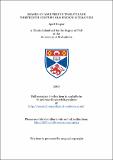Files in this item
Images of adultery in twelfth and thirteenth-century Old French literature
Item metadata
| dc.contributor.advisor | Hudson, John | |
| dc.contributor.author | Harper, April | |
| dc.coverage.spatial | 322 p. | en_US |
| dc.date.accessioned | 2018-06-27T12:05:30Z | |
| dc.date.available | 2018-06-27T12:05:30Z | |
| dc.date.issued | 2003 | |
| dc.identifier.uri | https://hdl.handle.net/10023/14654 | |
| dc.description.abstract | This thesis examines literary images of masculinity and femininity, their function and depiction in marriage roles and homo-social relationships in the context of crisis: wifely adultery. The study is heavily reliant upon vernacular texts, especially Old French works from the twelfth and thirteenth century including works from the genres of romance, lais, fables, and fabliaux. Latin works including historia and prescriptive texts such as customaries, penitentials, etiquette texts and medical and canon law treatises are also used to contextualise themes in the Old French literature. The introduction summarises modern literary and historical criticism concerning sexuality in the Middle Ages. It then discusses the influences of the Church, philosophy, medicine, natural theory and society on medieval definitions of sexuality to contextualise the literature which is focal to this thesis. The following four chapters each consider a single character in the adulterous affair: the adulteress, the husband, the lover and the accuser. The literary images of each character are analysed in detail revealing the diversity of depictions between and also within genres. This enables the identification of medieval sexual constructs, challenging some previous critiques of representations of sexuality in the Middle Ages. The final chapter explores the language by which the sexual act is presented. Furthermore, it shows how language is used and occasionally abused in committing, prosecuting and evading punishment for adultery and how it can be wielded as a weapon of women. Through the focus of a body of literature rich in depictions of sexuality, this thesis questions the misogynist overtones often attributed to medieval literature. The diversity of images shows that the literature illustrates a wide range of opinions and ideas reflective of the complexity of sexuality in medieval society. | en_US |
| dc.language.iso | en | en_US |
| dc.publisher | University of St Andrews | |
| dc.subject.lcc | PQ1304.H2 | |
| dc.subject.lcsh | Adultery in literature | en |
| dc.subject.lcsh | French literature--To 1500--History and criticism | en |
| dc.title | Images of adultery in twelfth and thirteenth-century Old French literature | en_US |
| dc.type | Thesis | en_US |
| dc.type.qualificationlevel | Doctoral | en_US |
| dc.type.qualificationname | PhD Doctor of Philosophy | en_US |
| dc.publisher.institution | The University of St Andrews | en_US |
This item appears in the following Collection(s)
Items in the St Andrews Research Repository are protected by copyright, with all rights reserved, unless otherwise indicated.

